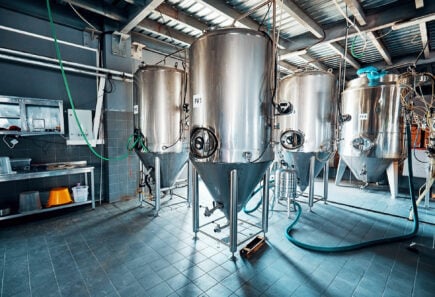Catalog of animal meat flavors
Creating a catalog of molecules responsible for the characteristic flavor of a species will enable alternative protein product manufacturers to create products that more accurately replicate the sensory experience of animal meats, removing a major barrier to their widespread adoption.
-
Cultivated
-
Fermentation
-
Plant-Based
- Research
- Commercial
- Ecosystem
- End Products
- Production
- R&D
- Raw Materials, Ingredients, & Inputs
- Crop development
- End product formulation & manufacturing
- Ingredient optimization
- Target molecule selection
- Industry
- Academics
- GFI
- NGO’s
- Startups
Current challenge
Alternative protein products are not yet widely adopted partly because many consumers think that they don’t taste like animal meat. While the flavor chemistry of some conventional animal meats has been characterized, flavor compounds are bioactive and thus may have complex interactions with other ingredients—such as proteins, fats, carbohydrates, minerals, and vitamins—in plant-based or other alternative protein product formulas. These interactions are not yet well-characterized. Additionally, more work is needed to make animal meat flavor information more readily available, to find non-animal sources of these flavor compounds, and to recreate the flavor profiles of animal meat that consumers desire. Comparisons between products and studies are difficult because there currently is not a universal, standardized language to describe animal meat flavors, as each sensory panel determines both the vocabulary in flavor assessments as well as the reference standards, rather than tastes being ascribed to specific molecular signatures.
Proposed solution
For some species—including chicken, snow crab, beef, and pork, as well as different cattle breeds such as Wagyu and Pirenaica and Friesian cattle—data exist for the molecules that contribute to flavor, and in some instances, the molecules that are most relevant to building the characteristic flavor. An organized, open-access catalog of flavor compounds in animal meat would compile the data from published literature so researchers can easily find molecules that are known to be responsible for characteristic meat flavors. Such a catalog would also allow researchers to quickly see the knowledge gaps where the characteristic molecules have yet to be determined for certain species or flavors.
The most important characteristic flavor molecules can be determined by sensory panels using omission tests, as has been done for snow crabs. Currently, both the vocabulary and reference standards used in sensory testing are determined by the panel itself. Due to the subjective nature of this practice, it is essential to have a panel that is representative of the population at large: diverse by metrics including but not limited to age, ethnicity, and geography. This diversity is necessary because physiological changes in the body due to aging, cultural upbringing, and food access may affect the ability and affinity to taste certain compounds. However, this variability complicates cross-study comparisons, and the requirement for larger or more diverse panels to reduce variability can add cost and time to the sensory assessment process. More holistic sensory data will enable the creation of chemical standards upon which an objective, universal lexicon for characteristic flavors of a species can be built.
Machine learning can be leveraged to compile the multitude of sensory terms used to describe flavors and create a universal lexicon for different meats. The resulting data can then be used to develop a catalog that one can use to select compounds that comprise a specific flavor profile. This catalog would contain information about the extracted flavor compounds, including but not limited to:
- Whether the molecule is a flavor-active or precursor compound for a specific flavor, classified by type. Relevant classifications may include elemental composition (e.g., sulfur, nitrogen), type of biomolecules (e.g., polyunsaturated free fatty acids or branched-chain fatty acids), and families or chemical classes of organic compounds or functional groups (e.g., ketones, carbonyls). These classifications have been made for fish and shellfish.
- The concentration of the volatile component in a species and the method by which it is measured. Techniques for isolating volatile aroma-active compounds may be biased by selecting for specific groups of molecules and also may differ by the extent of artifact formation. Using at least 2 methods that differ by compound isolate type reduces some of this bias, but studies may only include one method for testing. See the “Volatile Profiles” tabs on PISCES database, which organizes fish and seafood data, for reference.
- The species or other taxonomic level in which this molecule is found. Some molecules can contribute to species- or taxonomic group-specific flavors, while others create more ubiquitous “meaty” flavors.
- Whether the molecule comes from a cooked or raw sample of a species. Products may undergo temperature changes during production, storage, and cooking, potentially causing some components to volatilize out of the product or further bind, such as vanillin to pea or whey protein.
- The animal body part where the flavor compound is found (e.g., skeletal muscle, liver).
- Physiological conditions, pH, and water activity of the tissue from which the molecule is isolated. Post-mortem metabolism of animal meats may cause some precursors to become flavor active, which correlates to a decline in pH.
- Chemesthesis, or the physiological response that a taster might have to this compound in isolation or in conjunction with other molecules.
- Reactions that flavor compounds participate in within certain foods. Because synergy with other compounds can exacerbate off-flavors or enhance desired flavors, tracking the transformation of these compounds enables studies in preserving and optimizing compositions for accurate flavors.
Non-reactive interactions of flavor compounds with other compounds in foods during processing, storage, and cooking. For example, the grinding and extrusion that occurs when making ground meats or textured proteins may alter the stability of volatile and non-volatile components, which would influence the stage in which these compounds should be added during production. Foods are a highly complex matrix and certain interactions between proteins, fats, carbohydrates, minerals, and vitamins will influence the flavor.
Anticipated impact
A catalog would aid in highlighting the molecules that are indispensable to species’ characteristic flavors, allowing alternative protein manufacturers to recreate the sensory experience of animal counterparts. For example, the molecules most responsible for mutton’s characteristic flavor are branched-chain fatty acids (BCFAs), which Black Sheep Foods uses to flavor their plant-based lamb products. An open-access catalog of these flavor compounds would help expedite product development by reducing the number of trial-and-error experiments and duplicative efforts between research groups. Using the minimum number of compounds to achieve these flavors reduces production costs and subsequently the cost to take products to market. Once identified, molecules that impart desirable meat flavors can be synthesized chemically, produced biosynthetically via fermentation, or possibly sourced from existing plant-based sources to be used as ingredients in alternative protein products.
Such a catalog could also aid cultivated meat producers in identifying important differences in the composition of their products in comparison to conventional meat, thereby simplifying the optimization of their processes to achieve the desired flavor profile. An open-access catalog of animal flavor compounds that characterizes the naturally occurring components found in animal meats today will be useful for identifying key molecules to include in plant-based meat products and non-animal sources for these molecules.
By contributing to an open-access flavor catalog, flavor ingredient companies can educate their buyers about the comparison of their products to animal flavors, which would allow them to reach more consumers. Since companies more typically protect their ingredient information, data will more realistically initially be acquired from available literature and generated through open-access biochemical analytical research.
The structure and organization of an animal flavor catalog can serve as a basis for other alternative protein ingredient catalogs. For example, flavorhouses like Givaudan have identified that some off-flavors arise from the protein bases of plant-based meat products and thus have developed maskers to mitigate undesirable flavors. An open-access catalog of plant protein flavors and off-flavors would support the development of better methods to reduce off-flavors across the industry.
Related efforts
Fenaroli’s Handbook of Flavor Ingredients characterizes extracts and other flavoring products, specifying physical characteristics at specific temperatures, chemical components, and uses in products, which may be useful in selecting sections for the flavor catalog. FlavorDB is a database of flavor molecules and ingredients.
GFI resources

Introducing PISCES, a new data navigation tool to inform alternative seafood development
There’s a lot of research on the cellular and molecular components needed to match conventional seafood’s taste, texture, and aroma. We’ve put together a resource to help alternative seafood researchers…

Research grants
Learn about cutting-edge alternative protein research funded by GFI. Find funding opportunities for your own research.
Meet the author

Kim Lu
GFI RESEARCH FELLOW
Princeton University

Find collaborators
Join the GFIdeas global community of 2,000+ entrepreneurs, scientists, investors, and subject matter experts. Discuss projects on the members-only Slack community, attend monthly seminars, and use the community directory to help you find collaborators working on similar Solutions!
Related solutions
-
Cultivated
-
Fermentation
-
Plant-Based
Preventing oxidation of omega-3 fatty acids before and after addition to alternative seafood products
Deeper fundamental knowledge of the causes and prevention of oxidation of omega-3 fatty acids before, during, and after addition to alternative seafood products is needed to improve their nutritional and…
-
Cultivated
Post-harvest processes and end product characterization for cultivated meat
A number of cellular processes occurring after slaughter are known to affect the quality and sensory properties of conventional meat. Cultivated meat will offer unprecedented control over these parameters and…
Related GFI research grants

Identifying pea protein off flavors
Learn about Dr. Jian Li’s work at Beijing Technology and Business University to identify off flavors in pea protein and improve plant-based meat.

Fermenting flavor bases
Learn about GFI research grantee BZ Goldberg’s work at The Mediterranean Food Lab to develop better flavors for plant-based meat using fermentation.

Explore the full solutions database
Browse 100+ startup ideas, commercial opportunities, research projects, and investment priorities throughout the alternative protein supply chain.
Get involved
If you’d like to fund a research project, work on any of these solutions, share information about related efforts that are already underway, or elevate new ideas for advancing the alternative protein industry, we’d love to hear from you!
